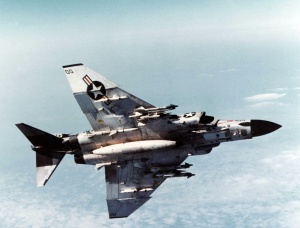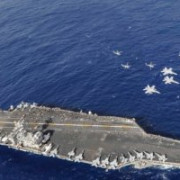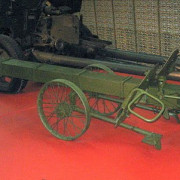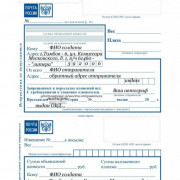Aim-9 sidewinder
Содержание:
History
Following the widespread use of early air-to-air missiles in the Vietnam War, it became apparent that such weapon systems had major limitations. They would frequently lose targets due to their IR seekers having a narrow field of view, or the missile not being manoeuvrable enough to keep on the tail of the target. In 1968, a team of engineers working at Hawker Siddeley Dynamics (the missiles division of Hawker Siddeley) began work on a new short-range air-to-air missile to address these shortcomings; the company funded the project as a private venture under the name «Taildog». The missile was to have an IR seeker with a wide field of view, capable of keeping track of targets under all conditions and would have to be extremely manoeuvrable.
The Taildog missile would be 2 m long and make use of thrust vectoring to give it excellent manoeuvrability. In 1970, the Ministry of Defence (MoD) decided that a new air-to-air missile with better manoeuvrability than the other missiles that were in service at the time was required. Hawker Siddeley Dynamics adapted their Taildog missile design to meet the new requirements and after evaluation, they were awarded the contract in 1972. Work on the programme continued under the name of Short Range Air-to-Air Missile or SRAAM. The SRAAM would be bigger than the Taildog (2.75 m long instead of 2 m) and feature a better thrust vectoring system. Due to budget cuts, the government cancelled the SRAAM program in 1974, instead choosing to pursue the Skyflash missile (a British upgrade to the United States AIM-7 Sparrow missile). The SRAAM program continued however until 1978 as a technology demonstrated.
In 1977, Hawker Siddeley Dynamics merged with the missiles division of British Aircraft Corporation (BAC) to form BAe Dynamics (other companies, including the rest of Hawker Siddeley, merged to form the remainder of British Aerospace (BAe). Starting in 1980 BAe Dynamics used research from the SRAAM programme to help with the development of the Advanced Short Range Air-to-Air Missile (ASRAAM), which is still in use to this day.
The SRAAM was 2.75 m long and weighed 70 kg. In-flight the missile was carried in a lunch tube to protect it until it was fired; once fired the missile had a series of small fins which unfolded to air stability (although they were fixed in place once deployed so did not help control the missile). In the life of the programme eight missiles were fired, some of which from Hawker hunter F.6 XG210. There was an incident during testing where immediately after launch the missile turned sharply after launch and almost collided with the Hunter that fired it.
The SRAAM has also been seen on the Trainer 2 seat version of the Harrier GR.1, they were only mounted for exhibition purposes.
Операторы
Текущие операторы
- Аргентина AIM-9L / M
- Австралия
- Бельгия
- Бахрейн
- Бразилия
- Канада
- Чили
- Чехия
- Дания
- Египет
- Эфиопия
- Финляндия
- Венгрия
- Греция
- Индонезия
- Иран
- Ирак
- Израиль
- Япония
- Иордания
- Кения
- Кувейт
- Малайзия
- Марокко
- Нидерланды
- Норвегия
- Оман
- Пакистан
- Филиппины
- Польша
- Португалия AIM-9B / J / P / L / M
- Катар
- Румыния
- Саудовская Аравия
- Сингапур
- Южная Корея
- Тайвань
- Швеция
- Швейцария
- Таиланд
- Турция
- Тунис
- Соединенные Штаты
- Объединенные Арабские Эмираты
- Венесуэла
Бывшие операторы
- Австрия
- Камерун
- Франция
- Германия
- Италия
- Мексика
- Новая Зеландия
- Южная Африка
- Испания
- Южный Вьетнам
- Объединенное Королевство
- Югославия
- Зимбабве
Обратите внимание, что этот список не является исчерпывающим.
External links
- References
- Westrum 2013, p.196
- ↑ Parsch 2008
- ↑ Kopp 2014
- ↑ GlobalSecurity.org «AIM-9 Sidewinder»
- ↑ Goebel 2021
- Bibliography
- Westrum, Ron. Sidewinder; Creative Missile Development at China Lake. Naval Institute Press, 30 Sep. 2013.
| Missiles | |
|---|---|
| USA | |
| AAM | AIM-7C Sparrow · AIM-7D Sparrow · AIM-7E Sparrow · AIM-7E-2 Sparrow |
| AIM-9B Sidewinder · AIM-9C Sidewinder · AIM-9D Sidewinder · AIM-9E Sidewinder · AIM-9G Sidewinder · AIM-9J Sidewinder · AIM-9L Sidewinder · AIM-9P Sidewinder | |
| AIM-92 Stinger | |
| AGM | AGM-12B Bullpup · AGM-12C Bullpup · AGM-22 · AGM-65A · AGM-65B · AGM-114B Hellfire · AGM-114K Hellfire II · BGM-71D TOW-2 |
| ATGM | BGM-71 TOW · BGM-71A TOW · BGM-71B TOW · BGM-71C I-TOW |
| SAM | MIM146 |
| Germany | |
| AAM | AIM-9B FGW.2 Sidewinder |
| AGM | HOT-1 · HOT-2 TOW · HOT-3 · PARS 3 LR |
| ATGM | HOT-K3S |
| SAM | Roland |
| USSR | |
| AAM | 9M39 Igla · R-3R · R-3S · R-13M · R-13M1 · R-23R · R-23T · R-24R · R-24T · R-60 · R-60M |
| AGM | 9K127 Vikhr · 9M17M Falanga · 9M17P Falanga-PV · 9M120 Ataka · 9M120-1 Ataka |
| Kh-23M · Kh-25 · Kh-25ML · Kh-29L · Kh-29T · Kh-66 | |
| ATGM | 3M7 · 9M14 · 9M113 Konkurs · 9M114 Shturm · 9M123 Khrizantema · 9M133 |
| SAM | 9M311 · 9M311-1M |
| Britain | |
| AAM | Fireflash · Firestreak · Red Top · Skyflash · SRAAM |
| ATGM | BAe Swingfire · MILAN · MILAN 2 · ZT3 |
| SAM | Starstreak |
| Japan | |
| ATGM | Type 64 MAT · Type 79 Jyu-MAT |
| SAM | Type 91 |
| China | |
| AAM | PL-2 · PL-5B |
| ATGM | HJ-73 · HJ-73E |
| SAM | HN-6 |
| Italy | |
| SAM | Mistral SATCP |
| France | |
| AAM | AA-20 Nord · Matra R530 · Matra R530E · Matra R550 Magic 1 · Mistral · Shafrir |
| AGM | 9M14-2 Malyutka-2 · AS-20 Nord · AS-30 Nord · AS-30L Nord · HOT-1 · HOT-2 TOW · HOT-3 |
| ATGM | HOT · SS.11 |
| SAM | Roland · VT1 |
| Sweden | |
| AAM | RB24 · RB24J · RB71 |
| AGM | Rb05A · RB 75 |
| ATGM | Rbs 55 · Rbs 56 |
| SAM | Rbs 70 |
| AAM = Air-to-Air Missile AGM = Air-to-Ground Missile ATGM = Anti-Tank Guided Missile (Ground mounts) SAM = Surface-to-Air Missile |
The infrared (IR) homing guidance section performs tracking and guidance functions. The AIM-9X is a system-guided missile employing a mid-wave IR FPA seeker. The seeker, equipped with High Off-Boresight (HOBS), can be used with a helmet-mounted sight for wider attack envelope. It uses passive infrared (IR) energy for target acquisition and tracking. After the launch, the seeker follows the heat signature from the engines of the hostile aircraft.
The IR homing ensures the launch of the missile during the day/night and in electronic countermeasure (ECM) environment. The missile can engage targets in the near beyond visual range (NBVR) and within visual range (WVR) areas.
History
Main article:
As the United States Navy improved on their initial Sidewinder model (AIM-9B) to the AIM-9D, another feature that the China Lake development team, headed by Chuck Smith, wanted to introduce into the missile was the Sidewinder Expanded Acquisition Mode (SEAM). SEAM allowed the Sidewinder to follow the aircraft’s radar search pattern and target acquisition. Being able to seek around a 25 degree angle in a circular scan, the Sidewinder would have a better chance of acquiring targets than earlier models that just aimed straight ahead. This feature, along with some solid-state module upgrades, were incorporated in the US Navy’s next Sidewinder model, the AIM-9G. The improvement was sufficient that the initial order of 5,000 AIM-9D seekers was cut at 1,850 units and the rest were built in AIM-9G seeker specifications. A total of 2,120 AIM-9G missiles would be built by Raytheon between 1970 to 1972. As the AIM-9G consisted upgrades to the seeker and electrical components, it did not differ externally from the AIM-9D variant.

A F-4J Phantom II from VF-96, attached to the USS Constellation (CVA-64), equipped with either AIM-9D or AIM-9Gs (their external features are identical).
The AIM-9G would see use alongside the AIM-9D as the US Navy’s choice for IR missile during the Vietnam War. A total of fourteen aircraft were claimed to have been downed by AIM-9Gs fired from a US Navy F-4J Phantom II plane, seven of which were MiG-17s and the other seven MiG-21s. During Operation Linebackers I and II in 1972, the US Navy recorded a high 46% hit rate with their AIM-9G, which is credited both to the missile design and USN fighter pilot training from the Navy’s Fighters Weapon School, also known as TOPGUN. The United States Air Force attempted to obtain AIM-9Gs from the US Navy due to poor experience with their AIM-9 Sidewinders models B, E, and J. However, the US Navy’s AIM-9s were not compatible with US Air Force’s Sidewinder launchers due to the differences in cooling mechanisms (the US Navy’s Sidewinder cooled by a nitrogen gas container installed on the launcher that the USAF did not have).
While the AIM-9G was thought to have been the peak of the Sidewinder’s capability at the time, several engineers at Philco-Ford (some of which helped create the first Sidewinder at China Lake) were brought in to continue improving the AIM-9 reliability, and one proposal was to convert all remaining missile electronic components to solid-state. The AIM-9G converted to an all solid-state technology, as well as an increased seeker tracking rate of 20 degrees/second, was designated the AIM-9H. This was introduced into the Navy in 1972 and 7,700 units would be produced between 1972-1974 by Philco-Ford and Raytheon.
Projects after the Vietnam War to continue improving the AIM-9s led to using the AIM-9H as the basis of the improvements. China Lake started the program as the AIM-9H Product Improvement Package (PIP). The United States Air Force, also seeking a missile improvement from their AIM-9E and AIM-9J models of the Sidewinder, became involved with the US Navy’s AIM-9H PIP under direction the Pentagon. The variety of improvements inputted by both service branches led to the missile that would be designated as the AIM-9L.
External links
References
- ↑ Goebel 2019
- ↑ Hollway
- ↑ Parsch 2008
- ↑ Gervasi 1984, p.256
- Parsch 2020
- Kopp 2014
- Bibliography
- Gervasi, Tom. America’s War Machine: the Pursuit of Global Dominance: Arsenal of Democracy III. Grove Press, Inc., 1984.
| Missiles | |
|---|---|
| USA | |
| AAM | AIM-7C Sparrow · AIM-7D Sparrow · AIM-7E Sparrow · AIM-7E-2 Sparrow |
| AIM-9B Sidewinder · AIM-9C Sidewinder · AIM-9D Sidewinder · AIM-9E Sidewinder · AIM-9G Sidewinder · AIM-9J Sidewinder · AIM-9L Sidewinder · AIM-9P Sidewinder | |
| AIM-92 Stinger | |
| AGM | AGM-12B Bullpup · AGM-12C Bullpup · AGM-22 · AGM-65A · AGM-65B · AGM-114B Hellfire · AGM-114K Hellfire II · BGM-71D TOW-2 |
| ATGM | BGM-71 TOW · BGM-71A TOW · BGM-71B TOW · BGM-71C I-TOW |
| SAM | MIM146 |
| Germany | |
| AAM | AIM-9B FGW.2 Sidewinder |
| AGM | HOT-1 · HOT-2 TOW · HOT-3 · PARS 3 LR |
| ATGM | HOT-K3S |
| SAM | Roland |
| USSR | |
| AAM | 9M39 Igla · R-3R · R-3S · R-13M · R-13M1 · R-23R · R-23T · R-24R · R-24T · R-60 · R-60M |
| AGM | 9K127 Vikhr · 9M17M Falanga · 9M17P Falanga-PV · 9M120 Ataka · 9M120-1 Ataka |
| Kh-23M · Kh-25 · Kh-25ML · Kh-29L · Kh-29T · Kh-66 | |
| ATGM | 3M7 · 9M14 · 9M113 Konkurs · 9M114 Shturm · 9M123 Khrizantema · 9M133 |
| SAM | 9M311 · 9M311-1M |
| Britain | |
| AAM | Fireflash · Firestreak · Red Top · Skyflash · SRAAM |
| ATGM | BAe Swingfire · MILAN · MILAN 2 · ZT3 |
| SAM | Starstreak |
| Japan | |
| ATGM | Type 64 MAT · Type 79 Jyu-MAT |
| SAM | Type 91 |
| China | |
| AAM | PL-2 · PL-5B |
| ATGM | HJ-73 · HJ-73E |
| SAM | HN-6 |
| Italy | |
| SAM | Mistral SATCP |
| France | |
| AAM | AA-20 Nord · Matra R530 · Matra R530E · Matra R550 Magic 1 · Mistral · Shafrir |
| AGM | 9M14-2 Malyutka-2 · AS-20 Nord · AS-30 Nord · AS-30L Nord · HOT-1 · HOT-2 TOW · HOT-3 |
| ATGM | HOT · SS.11 |
| SAM | Roland · VT1 |
| Sweden | |
| AAM | RB24 · RB24J · RB71 |
| AGM | Rb05A · RB 75 |
| ATGM | Rbs 55 · Rbs 56 |
| SAM | Rbs 70 |
| AAM = Air-to-Air Missile AGM = Air-to-Ground Missile ATGM = Anti-Tank Guided Missile (Ground mounts) SAM = Surface-to-Air Missile |
Ссылки [ править ]
- ^ Brevoort, Том; ДеФалко, Том; Мэннинг, Мэтью К .; Сандерсон, Питер; Вячек, Вин (2017). Marvel год за годом: визуальная история . DK Publishing. п. 223. ISBN 978-1465455505.
- ^ Официальный справочник вселенной Marvel # 10
- ^ Ровин, Джефф (1987). Энциклопедия суперзлодеев . Нью-Йорк: факты в файле. п. 316. ISBN. 0-8160-1356-X.
- ↑ Marvel Два в одном # 64
- ^ Капитан Америка # 308-311, 313
- ^ Капитан Америка # 315
- ^ Капитан Америка # 319
- ^ Капитан Америка # 338
- ^ Капитан Америка # 341-342
- ^ Капитан Америка # 345
- ↑ Uncanny X-Men Annual # 13.
- ^ Капитан Америка # 380-381
- ^ Капитан Америка Ежегодник # 10
- ↑ Капитан Америка (т. 1) # 424
- ^ Новые молнии # 7
- ^ Железный кулак об. 3 # 1 (1998)
- ^ Официальный справочник вселенной Marvel: Команды 2005
- ^ Все новые официальные справочники по Вселенной, обновление №2
- ^ Капитан Америка Том. 4 # 31 (ноябрь 2004 г.)
- ↑ Nova Vol. 4 # 19
- ↑ Капитан Америка: Сэм Уилсон # 4
- ↑ Капитан Америка: Стив Роджерс # 16
- ^ Официальный справочник вселенной Marvel № 10, стр. 9
- ↑ Капитан Америка, № 318, стр. 18, панель 2
- ^ Совершенно новые ультимейты # 2-6
Силы и способности
У Sidewinder есть плащ, созданный учеными из лаборатории мутагенеза Brand Corporation, дочерней компании Roxxon, на основе технологии Nth Projector, которая содержит электронные схемы, позволяющие пользователю открыть отверстие в другое измерение. Сайдвиндер мысленно активирует плащ с помощью устройства, имплантированного в его тело, позволяя ему путешествовать «боком» через межпространственное пространство, забирая с собой все, кого бы он ни накинул на свой плащ. Это позволяет ему телепортироваться на расстояние до 50 миль (80 км) за один «прыжок». Чип кибернетического контроля, имплантированный в мозг Сайдвиндера, позволяет ему управлять им с очень высокой точностью и активировать заранее запрограммированные координаты, если он нокаутирован или тяжело ранен
Он принял меры предосторожности, имплантировав чипы-локаторы своим союзникам, что позволило ему телепортироваться к их местоположению. Сайдвиндер может телепортировать все, что может прикрыть его плащ, до приблизительного размера и формы другого человека
Броня Сайдвиндера обеспечивает защиту от огня из стрелкового оружия, а ребризер позволяет ему выжить под водой в течение продолжительных периодов времени. У него также есть способность испускать энергетические усики, которые он называет «побочными эффектами», со своего лба. Неясно, является ли это естественной способностью или функцией его брони. Сет Фолькер на самом деле не обладает сверхчеловеческими способностями. Он опытный финансовый эксперт, бизнес-планировщик и стратег. Имеет ученую степень в области экономики.
General info
The SRAAM is a highly manoeuvrable infrared homing air-to-air missile. The missile’s use of thrust vectoring, and an IR seeker with very wide gimbal limits, means that it can track targets incredibly well compared to other air-to-air missiles. The missile has an uncaged seeker with a very wide gimbal limits, which makes maintaining locks on targets prior to launch much easier. The uncaged seeker also means that once the missile has been locked you can turn the plane and «lead» the missiles, as if you would an aircraft’s guns, making them much more likely to hit.
Thrust vectoring also allows the missiles to start manoeuvring immediately after launch, unlike more traditional missiles which need to gain speed before their fins become fully effective; making the SRAAM much better suited for short range combat.
The SRAAMs are carried in launch tubes, mounted in pairs under the wings.
Effective damage
The SRAAM has a relatively small warhead consisting of 4 kg of TNT with a 5 m proximity fuse. Most of the time this is adequate to outright destroy an enemy aircraft, however depending on the location of the missile when it explodes it is possible the target will only receive a varying amount of damage. While it is not uncommon for the enemy aircraft to eventually crash due to the damage they receive, some can make it back to the airfield or even continue fighting.
Comparison with analogues
The main standout feature of the SRAAM, which sets it apart from all other infrared homing missiles (carried by fixed-wing aircraft at least) is its astonishingly good manoeuvrability. The SRAAM can pull a maximum overload of 20 G, the joint highest value along with the AIM-9L, and double that of the next best missiles found on fixed-wing aircraft (the AIM-9D and AIM-9E). Despite having the same maximum overload the SRAAM is still capable of out-manoeuvring the AIM-9L, owing to its thrust vectoring system. The SRAAM also powers up its IR seeker faster than other missiles (taking 3 seconds while most others take closer to 5), and can keep its seeker active for longer at 20 seconds (Sidewinders can do it for 10 seconds, and most Russian missiles 15 seconds).
The drawback of the SRAAM, however, is its short range, it is largely ineffective at ranges greater than 1 km; by comparison, other missiles such as the AIM-9E can hit targets from well over 2 km in a good situation. The SRAAM also has lower explosive mass than other missiles, at 4 kg of TNT. By comparison, the AIM-9B, D and E have 4.5 kg, the R-13M has 5.5 kg, and the R-3S has 11 kg.
Usage in battles
Overview
AIM-9J is a great tool for any situation where a gun cannot suffice or the pilot has no time to engage. After having used other infrared missiles, the AIM-9J takes virtually no time to get used to.
Deploying AIM-9J in combat
AIM-9J is best used when having to chase an enemy fighter that is accelerating away from you, or is outside of effective gun range. Timing is key to success when using AIM-9J, since unlike any other type of armament, AIM-9J requires 5 seconds to warm up before readiness for launch, after which the missile seeker will remain active for 10 seconds. So it is recommended to plan a missile launch shortly ahead of warmup, such as picking out the target ahead in time and then positioning the engagement to your advantage. AIM-9J is most effective in distances from 0.75-3 km at altitudes below 4 km, or 1-4 km above 4 km of altitude. Furthermore, it is recommended to only fire AIM-9J against the targets rear, preferably with an active afterburner to ensure continuous tracking towards AIM-9J’s upcoming flight. However, when attempting to engage a target moving on a tangent to the launch aircraft, it is recommended to lead the missile slightly towards the target, to ensure the track is sustained throughout the flight. In most cases though, the excellent seeker of AIM-9J will stay on target, even when flares or other countermeasures are deployed. The only threat to AIM-9J worth mentioning are heavily turning targets, due to its limited maximum G-load of 20G, therefore making it not an impossible task to dodge AIM-9J.
Pros and cons
Pros:
- TNT load sufficient to kill any aircraft it hits when compared to opposing aircrafts missiles such as R-60
- Accurate seeker hard to distract with flares
- Radar can assist the missile to pick the right target before launch
Cons:
- Does not follow hard turning targets well unlike R-60 or R550
- Seeker remains warmed up for only 10 seconds
Similar Weapons
Box Office/Improved Sidewinder
This formerly classified USAF program began in 1988 in conjunction with Raytheon to overhaul Sidewinder design. The missile introduces tail control with small independently activated tail fins shaped like those on the MIM-104 Patriot, and eliminates wings and rollerons, relying on the body for lift. The missile has greater acceleration, a 50-g maneuvering capability, and fits into 1/4 of the weapons bay space required for conventional AIM-9. The guidance system offers Electronically Erasable Programmable Read- Only Memory (EEPROM), and a digital roll-control autopilot.
The «Box size» (i.e., the square dimensions of its container) is 7.9 in (200 mm) compared to the 20 in (508 mm) of the standard Sidewinder. Obviously, the Box Office is designed to be fitted in the internal weapons bay of aircraft such as the F-22, so more can be carried in a given volume.
Boa
Similar to Box Office, but undertaken by the US Naval Air Test Center at China Lake, CA. The wings are merely reduced in size instead of being eliminated.
Более поздние разработки
Ракетный двигатель большего размера
В рамках проекта High Altitude Project инженеры China Lake соединили боеголовку Sidewinder и ГСН с ракетным двигателем Sparrow, чтобы поэкспериментировать с полезностью двигателя большего размера.
Другие наземные стартовые платформы
В 2016 году AIM-9X прошел испытательный пуск из многоцелевой пусковой установки на ракетном полигоне Уайт-Сэндс в Нью-Мексико , США. Во время тестирования с MML у AIM-9X возникли проблемы с перегревом. С тех пор эти проблемы были решены. В сентябре 2021 года армия США подписала контракт с Dynetics на создание прототипов системы защиты от косвенного возгорания (IFPC) с использованием пусковой установки на основе MML, запускающей Sidewinder для противодействия БПЛА и крылатым ракетам. Ввод в эксплуатацию планируется в 2023 году.
В мае 2019 года AIM-9X Block II прошел испытательные стрельбы из Национальной усовершенствованной зенитно-ракетной системы ( NASAMS ) в испытательном центре Андоя в Норвегии.
External links
- References
- Westrum 2013, p.176
- ↑ Westrum 2013, p.182-184
- ↑ Parsch 2008
- Westrum 2013, p.184-186
- McCarthy 2009, p.148-157
- ↑ Parsch 2002
- Westrum 2013, p.186
- Rogoway 2017
- Bibliography
- McCarthy, Donald J. Jr. MiG Killers, A Chronology of U.S. Air Victories in Vietnam 1965–1973. Specialty Press, 2009.
- Westrum, Ron. Sidewinder; Creative Missile Development at China Lake. Naval Institute Press, 30 Sep. 2013.
| Missiles | |
|---|---|
| USA | |
| AAM | AIM-7C Sparrow · AIM-7D Sparrow · AIM-7E Sparrow · AIM-7E-2 Sparrow |
| AIM-9B Sidewinder · AIM-9C Sidewinder · AIM-9D Sidewinder · AIM-9E Sidewinder · AIM-9G Sidewinder · AIM-9J Sidewinder · AIM-9L Sidewinder · AIM-9P Sidewinder | |
| AIM-92 Stinger | |
| AGM | AGM-12B Bullpup · AGM-12C Bullpup · AGM-22 · AGM-65A · AGM-65B · AGM-114B Hellfire · AGM-114K Hellfire II · BGM-71D TOW-2 |
| ATGM | BGM-71 TOW · BGM-71A TOW · BGM-71B TOW · BGM-71C I-TOW |
| SAM | MIM146 |
| Germany | |
| AAM | AIM-9B FGW.2 Sidewinder |
| AGM | HOT-1 · HOT-2 TOW · HOT-3 · PARS 3 LR |
| ATGM | HOT-K3S |
| SAM | Roland |
| USSR | |
| AAM | 9M39 Igla · R-3R · R-3S · R-13M · R-13M1 · R-23R · R-23T · R-24R · R-24T · R-60 · R-60M |
| AGM | 9K127 Vikhr · 9M17M Falanga · 9M17P Falanga-PV · 9M120 Ataka · 9M120-1 Ataka |
| Kh-23M · Kh-25 · Kh-25ML · Kh-29L · Kh-29T · Kh-66 | |
| ATGM | 3M7 · 9M14 · 9M113 Konkurs · 9M114 Shturm · 9M123 Khrizantema · 9M133 |
| SAM | 9M311 · 9M311-1M |
| Britain | |
| AAM | Fireflash · Firestreak · Red Top · Skyflash · SRAAM |
| ATGM | BAe Swingfire · MILAN · MILAN 2 · ZT3 |
| SAM | Starstreak |
| Japan | |
| ATGM | Type 64 MAT · Type 79 Jyu-MAT |
| SAM | Type 91 |
| China | |
| AAM | PL-2 · PL-5B |
| ATGM | HJ-73 · HJ-73E |
| SAM | HN-6 |
| Italy | |
| SAM | Mistral SATCP |
| France | |
| AAM | AA-20 Nord · Matra R530 · Matra R530E · Matra R550 Magic 1 · Mistral · Shafrir |
| AGM | 9M14-2 Malyutka-2 · AS-20 Nord · AS-30 Nord · AS-30L Nord · HOT-1 · HOT-2 TOW · HOT-3 |
| ATGM | HOT · SS.11 |
| SAM | Roland · VT1 |
| Sweden | |
| AAM | RB24 · RB24J · RB71 |
| AGM | Rb05A · RB 75 |
| ATGM | Rbs 55 · Rbs 56 |
| SAM | Rbs 70 |
| AAM = Air-to-Air Missile AGM = Air-to-Ground Missile ATGM = Anti-Tank Guided Missile (Ground mounts) SAM = Surface-to-Air Missile |
External links
- References
- ↑ Goebel 2019
- ↑ Hollway
- ↑ Parsch 2008
- ↑ Gervasi 1984, p.256
- Parsch 2020
- ↑ Kopp 2014
- Siemann 1974, p.9-12
- Siemann 1974, p.15-16
- Bibliography
- Gervasi, Tom. America’s War Machine: the Pursuit of Global Dominance: Arsenal of Democracy III. Grove Press, Inc., 1984.
- Siemann, John W. Project CHECO Southeast Asia Report. COMBAT SNAP (AIM-9J Southeast Asia Introduction). Defense Technical Information Center, 24 Apr 1974.
| Missiles | |
|---|---|
| USA | |
| AAM | AIM-7C Sparrow · AIM-7D Sparrow · AIM-7E Sparrow · AIM-7E-2 Sparrow |
| AIM-9B Sidewinder · AIM-9C Sidewinder · AIM-9D Sidewinder · AIM-9E Sidewinder · AIM-9G Sidewinder · AIM-9J Sidewinder · AIM-9L Sidewinder · AIM-9P Sidewinder | |
| AIM-92 Stinger | |
| AGM | AGM-12B Bullpup · AGM-12C Bullpup · AGM-22 · AGM-65A · AGM-65B · AGM-114B Hellfire · AGM-114K Hellfire II · BGM-71D TOW-2 |
| ATGM | BGM-71 TOW · BGM-71A TOW · BGM-71B TOW · BGM-71C I-TOW |
| SAM | MIM146 |
| Germany | |
| AAM | AIM-9B FGW.2 Sidewinder |
| AGM | HOT-1 · HOT-2 TOW · HOT-3 · PARS 3 LR |
| ATGM | HOT-K3S |
| SAM | Roland |
| USSR | |
| AAM | 9M39 Igla · R-3R · R-3S · R-13M · R-13M1 · R-23R · R-23T · R-24R · R-24T · R-60 · R-60M |
| AGM | 9K127 Vikhr · 9M17M Falanga · 9M17P Falanga-PV · 9M120 Ataka · 9M120-1 Ataka |
| Kh-23M · Kh-25 · Kh-25ML · Kh-29L · Kh-29T · Kh-66 | |
| ATGM | 3M7 · 9M14 · 9M113 Konkurs · 9M114 Shturm · 9M123 Khrizantema · 9M133 |
| SAM | 9M311 · 9M311-1M |
| Britain | |
| AAM | Fireflash · Firestreak · Red Top · Skyflash · SRAAM |
| ATGM | BAe Swingfire · MILAN · MILAN 2 · ZT3 |
| SAM | Starstreak |
| Japan | |
| ATGM | Type 64 MAT · Type 79 Jyu-MAT |
| SAM | Type 91 |
| China | |
| AAM | PL-2 · PL-5B |
| ATGM | HJ-73 · HJ-73E |
| SAM | HN-6 |
| Italy | |
| SAM | Mistral SATCP |
| France | |
| AAM | AA-20 Nord · Matra R530 · Matra R530E · Matra R550 Magic 1 · Mistral · Shafrir |
| AGM | 9M14-2 Malyutka-2 · AS-20 Nord · AS-30 Nord · AS-30L Nord · HOT-1 · HOT-2 TOW · HOT-3 |
| ATGM | HOT · SS.11 |
| SAM | Roland · VT1 |
| Sweden | |
| AAM | RB24 · RB24J · RB71 |
| AGM | Rb05A · RB 75 |
| ATGM | Rbs 55 · Rbs 56 |
| SAM | Rbs 70 |
| AAM = Air-to-Air Missile AGM = Air-to-Ground Missile ATGM = Anti-Tank Guided Missile (Ground mounts) SAM = Surface-to-Air Missile |
General info
Like other early air-to-air missiles, the AIM-9B is limited in is destructive capabilities. Although it contains enough explosive filler to eliminate or cripple an enemy given a direct hit, those direct hits may be hard to come by. For one, this missile only has a 10G overload. Therefore, it is quite easy for an enemy to dodge it. All the enemy needs to do is to turn slightly, and the missile will likely miss. For greatest lethality, use this missile on slow targets that cannot manoeuvre well (though it should be noted that in this case, guns may be just as effective).
Additionally, the AIM-9B takes quite a length of time to acquire a target. (The time required may be reduced if the enemy is using their afterburner.) So, even achieving a firing solution may prove difficult.
Still, as one of the first air-to-air missiles in the game, the missile is quite effective for dealing with enemies in the right circumstances. Careful positioning and trigger discipline are required. In lower-tier jet combat, the AIM-9B is the gold standard for long to medium range air-to-air combat.
Effective damage
With a 4.76 kg HBX explosive (7.62 kg TNT equivalent) warhead, the AIM-9B Sidewinder can ensure the destruction of the hit aircraft’s tail section. Even a near-miss with the proximity fuse detonating can cause significant damage to the rear control surfaces so that a critical hit will cause the plane to lose air controllability, leading to a credit when the plane eventually smashes into the ground.
Comparison with analogues
- AIM-9B FGW.2 Sidewinder — A European-licensed version of the AIM-9B with their own improvements; however the performance in-game are quite similar.
- R-3S/PL-2 — Infamous as a reverse-engineered variant of the AIM-9B, the R-3 missile shares many of its in-game performances with the AIM-9B, only falling slightly short in locking and launching range.
- Shafrir — Shares in-game performance values despite their design differences
- Rb24 — Licensed-produced version of the AIM-9B for the Swedish, and as such shares in-game performance values.
General info
The AIM-9G Sidewinder is a rear aspect IR guided short-ranged air-to-air missile. It functions similarly to previous variants of the AIM-9 but with more reliable avionics which allow it to sustain higher G-loads.
Effective damage
AIM-9G uses a newer continuous rod warhead with an improved proximity fuse, this allows less explosives to be used while increasing all around damage. The missile usually guarantees a one shot kill at most angles due to the continuous rod warhead.
Comparison with analogues
The Soviet R-3S aka K-13 missile and British SRAAM are comparable IR guided short range missiles. Compared to the R-3S, the AIM-9G has better speed, range, and G load capabilities and is an all round superior missile. The SRAAM has superior avionics capabilities to the Sidewinder with better acquisition envelope, higher G load, and is able to better make horizontal shots, but has a shorter engagement range at only 2 km.
Proiecta
Sidewinder nu este ghidat pe poziția efectivă înregistrată de detector, ci pe schimbarea poziției de la ultima vizionare. Deci, dacă ținta a rămas la 5 grade stânga între două rotații ale oglinzii, electronica nu ar emite niciun semnal către sistemul de control. Luați în considerare o rachetă lansată în unghi drept față de țintă; dacă racheta zboară la aceeași viteză cu ținta, ar trebui să o „conducă” cu 45 de grade, zburând către un punct de impact situat în fața locului în care se afla ținta când a fost lansată. Dacă racheta călătorește de patru ori viteza țintei, ar trebui să urmeze un unghi de aproximativ 11 grade în față. În ambele cazuri, racheta ar trebui să păstreze acel unghi până la interceptare, ceea ce înseamnă că unghiul pe care ținta îl face împotriva detectorului este constant. Acesta a fost un unghi constant pe care Sidewinder a încercat să îl mențină. Acest sistem de „ urmărire proporțională ” este foarte ușor de implementat, totuși oferă calcul de performanță de înaltă performanță aproape gratuit și poate răspunde la modificările din traseul de zbor al țintei, care este mult mai eficient și face ca racheta să „conducă” ținta.
History
In 1949, a small team at NOTS (later NWC) China Lake, led by Dr. McLean, investigated the passive Infra Red homing problem, with limited financial means. Surprisingly, the result of this low-profile research project is still known as one of the world’s leading dogfight missiles. As if the financial limitations were not restrictive enough, the team imposed on itself one further restriction: it chose for an airframe of only 5 inch (127mm) diameter, which made fitting in the necessary electronics (still vacuum-tube in those days) a major challenge. The research led to a contract, awarded to Philco in 1951, for a homing head.
On 11 September 1953, the first successful missile, designated XAAM-N-7, was fired and the missile reached IOC in 1956. Designations were N-7 (US Navy), GAR-8 (USAF) and SW-1 (Development). The AIM-9 designation was assigned to the Sidewinder in 1962, while RB.74 is the Swedish designation. Over the years, the missile has been continuously improved and updated, the latest projected versions being the AIM-9R and AIM-9X.
Use[]
It should be noted that the AIM-9 can be mounted to the outer hard points of the F/A-26B in sets of up to 3 each, giving the pilot up to 6 missiles across only 2 hard points. The AIM-9 can additionally be mounted on other hard points as well, allowing for the setup of a lightweight air-to-air payload if budget is an issue. The AIM-9 is a short range infrared missile, used in dog-fighting and pop-up attacks when radar-guided missiles are no longer practical. When the missile is selected, it will emit a low tone when not targeting a heat signature. Once it identifies a heat signature, its tone will increase; a stronger tone designates a more reliable lock. A predicted intercept point will also be displayed on the HUD, leading the target aircraft when you have obtained a strong lock. The missile has much higher maneuverability than other missiles like the AIM-120, letting it maneuver more sharply to hit its target. It is the cheapest of the Air-to-Air missile family, making it very economical for low budget missions. While the missile can fire and track at extreme angles, aligning your aircraft closer to the predicted
Rack of 3 AIM-9 missiles.
impact point and closing range will always improve results. Most fighters are equipped with countermeasure dispensers with flares for evading heat-seeking missiles. The AIM-9 is particularly vulnerable to this, being easily «distracted» by flares launched from the defending aircraft. This can be counteracted somewhat efficiently by launching the missile closer to the target.
Warning: Please take care when firing any IR missile in close proximity to friendly units. The IR missiles will reliably track whichever heat source is targeted, but if a friendly aircraft passes in front of the missile, especially if their heat signature is stronger, the missile’s seeker could become confused and target them instead. Stick to your Cannons if you are dogfighting near allies.
External links
- References
- ↑ Goebel 2019
- ↑ Hollway «The AIM-9 Sidewinder: Fox Two!»
- ↑ Parsch 2008
- ↑ Gervasi 1984, p.256
- Parsch 2020
- Lai 2016
- Siemann 1974, p.xii
- ↑ Kopp 2014
- Bibliography
- Gervasi, Tom. America’s War Machine: the Pursuit of Global Dominance: Arsenal of Democracy III. Grove Press, Inc., 1984.
- Lai, Benjamin. The Dragon’s Teeth: The Chinese People’s Liberation Army — Its History, Traditions, and Air Sea and Land Capability in the 21st Century. Casemate Publishers, 14 July 2016.
- Siemann, John W. Project CHECO Southeast Asia Report. COMBAT SNAP (AIM-9J Southeast Asia Introduction). Defense Technical Information Center, 24 Apr 1974.
| Missiles | |
|---|---|
| USA | |
| AAM | AIM-7C Sparrow · AIM-7D Sparrow · AIM-7E Sparrow · AIM-7E-2 Sparrow |
| AIM-9B Sidewinder · AIM-9C Sidewinder · AIM-9D Sidewinder · AIM-9E Sidewinder · AIM-9G Sidewinder · AIM-9J Sidewinder · AIM-9L Sidewinder · AIM-9P Sidewinder | |
| AIM-92 Stinger | |
| AGM | AGM-12B Bullpup · AGM-12C Bullpup · AGM-22 · AGM-65A · AGM-65B · AGM-114B Hellfire · AGM-114K Hellfire II · BGM-71D TOW-2 |
| ATGM | BGM-71 TOW · BGM-71A TOW · BGM-71B TOW · BGM-71C I-TOW |
| SAM | MIM146 |
| Germany | |
| AAM | AIM-9B FGW.2 Sidewinder |
| AGM | HOT-1 · HOT-2 TOW · HOT-3 · PARS 3 LR |
| ATGM | HOT-K3S |
| SAM | Roland |
| USSR | |
| AAM | 9M39 Igla · R-3R · R-3S · R-13M · R-13M1 · R-23R · R-23T · R-24R · R-24T · R-60 · R-60M |
| AGM | 9K127 Vikhr · 9M17M Falanga · 9M17P Falanga-PV · 9M120 Ataka · 9M120-1 Ataka |
| Kh-23M · Kh-25 · Kh-25ML · Kh-29L · Kh-29T · Kh-66 | |
| ATGM | 3M7 · 9M14 · 9M113 Konkurs · 9M114 Shturm · 9M123 Khrizantema · 9M133 |
| SAM | 9M311 · 9M311-1M |
| Britain | |
| AAM | Fireflash · Firestreak · Red Top · Skyflash · SRAAM |
| ATGM | BAe Swingfire · MILAN · MILAN 2 · ZT3 |
| SAM | Starstreak |
| Japan | |
| ATGM | Type 64 MAT · Type 79 Jyu-MAT |
| SAM | Type 91 |
| China | |
| AAM | PL-2 · PL-5B |
| ATGM | HJ-73 · HJ-73E |
| SAM | HN-6 |
| Italy | |
| SAM | Mistral SATCP |
| France | |
| AAM | AA-20 Nord · Matra R530 · Matra R530E · Matra R550 Magic 1 · Mistral · Shafrir |
| AGM | 9M14-2 Malyutka-2 · AS-20 Nord · AS-30 Nord · AS-30L Nord · HOT-1 · HOT-2 TOW · HOT-3 |
| ATGM | HOT · SS.11 |
| SAM | Roland · VT1 |
| Sweden | |
| AAM | RB24 · RB24J · RB71 |
| AGM | Rb05A · RB 75 |
| ATGM | Rbs 55 · Rbs 56 |
| SAM | Rbs 70 |
| AAM = Air-to-Air Missile AGM = Air-to-Ground Missile ATGM = Anti-Tank Guided Missile (Ground mounts) SAM = Surface-to-Air Missile |
General info
The AIM-9E is a direct upgrade over the previous AIM-9B missile, and on many aircraft serves as a upgrade over that missile. The AIM-9E provides a missile with a higher top speed and therefore higher energy meaning it is more capable of hitting targets at slightly further ranges and gives the target less time to dodge. The missile features a much larger seeker cone meaning the missile will not lose lock as easily.
Effective damage
Like the -9B, this weapon features a 4.5 kg warhead that will generally destroy an aircraft in one shot providing the weapon scores a direct hit. In some cases the weapon may deal crippling damage such as setting fires or blowing off a wing without necessarily scoring a kill. Not scoring a direct hit will result in greatly reduced damage.
Operatori
Operatori actuali
- Argentina AIM-9L / M
- Australia
- Belgia
- Bahrain
- Brazilia
- Canada
- Chile
- Republica Cehă
- Danemarca
- Egipt
- Etiopia
- Finlanda
- Ungaria
- Grecia
- Indonezia
- Iran
- Irak
- Israel
- Japonia
- Iordania
- Kenya
- Kuweit
- Malaezia
- Maroc
- Olanda
- Norvegia
- Oman
- Pakistan
- Filipine
- Polonia
- Portugalia AIM-9B / J / P / L / M
- Qatar
- România
- Arabia Saudită
- Singapore
- Coreea de Sud
- Taiwan
- Suedia
- Elveţia
- Tailanda
- curcan
- Tunisia
- Statele Unite
- Emiratele Arabe Unite
- Venezuela
Foști operatori
- Austria
- Camerun
- Franţa
- Germania
- Italia
- Mexic
- Noua Zeelandă
- Africa de Sud
- Spania
- Vietnamul de Sud
- Regatul Unit
- Iugoslavia
- Zimbabwe
Vă rugăm să rețineți că această listă nu este exhaustivă.







